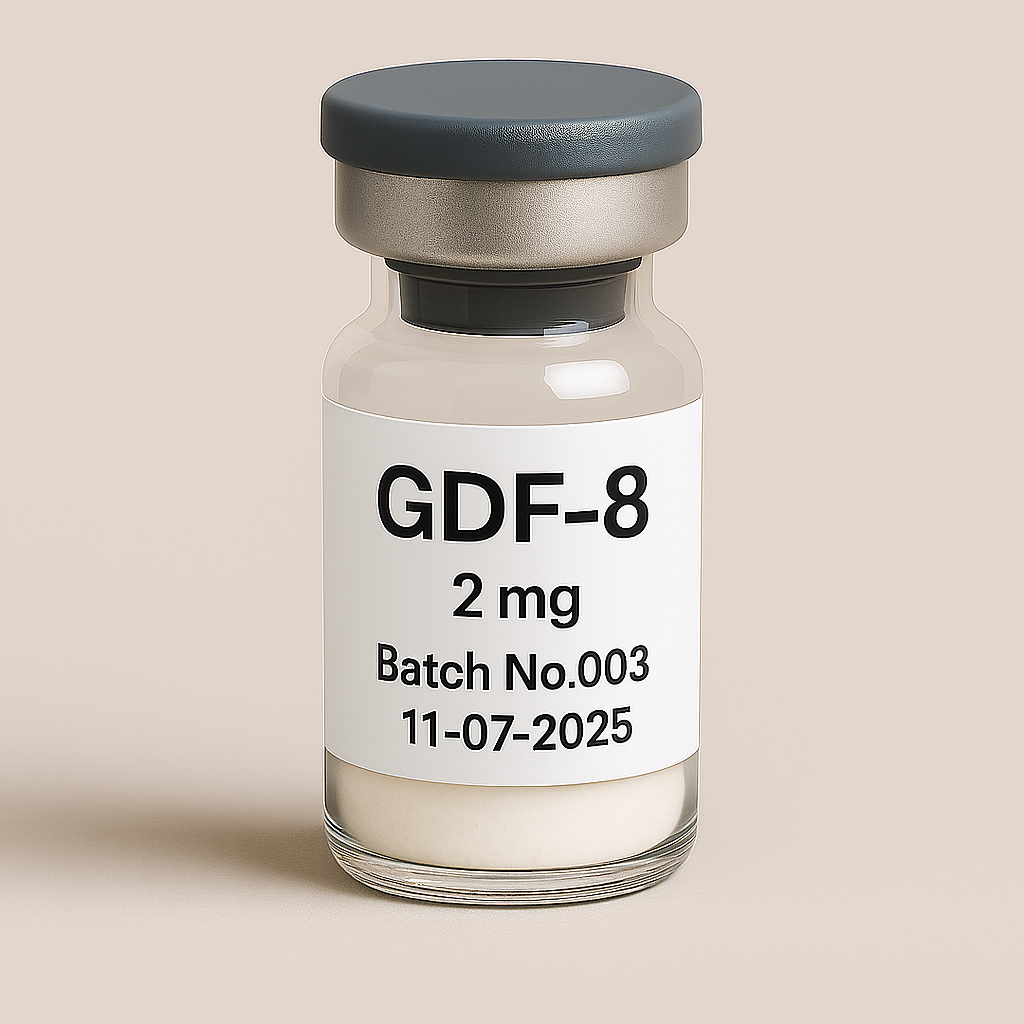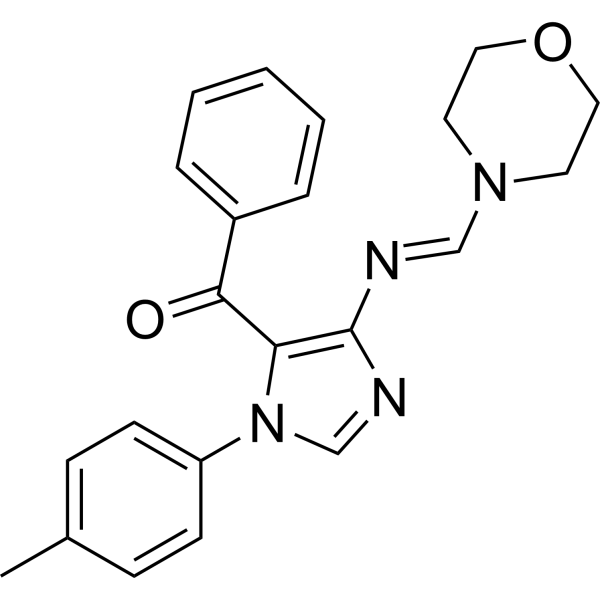
GDF-8 2mg vial
Pickup currently not available
NOT FOR HUMAN CONSUMPTION
Growth Differentiation Factor-8 (GDF-8), commonly known as Myostatin, is a protein belonging to the transforming growth factor-beta (TGF-β) superfamily. Identified in 1997, myostatin is primarily known as a potent negative regulator of skeletal muscle growth. Genetic mutations or pharmacological inhibition of myostatin leads to remarkable increases in muscle mass, making it a focal point of research in treating muscle-wasting diseases and enhancing muscle performance.
Biological Properties
-
Full Name: Growth Differentiation Factor-8 (GDF-8)
-
Family: TGF-β (transforming growth factor-beta) superfamily
-
Role: Negative regulator of skeletal muscle growth
-
Expression: Predominantly expressed in skeletal muscle; also found at lower levels in adipose tissue and cardiac muscle
-
Mechanism of Action: Acts through activin type-II receptors (ActRIIB), inhibiting muscle cell proliferation and differentiation
Mechanism of Action
Myostatin functions primarily through the following mechanisms:
1. Muscle Growth Inhibition
-
Binds to activin type II receptors (ActRIIB) on muscle cells, activating Smad2/Smad3 signaling pathways.
-
Suppresses muscle hypertrophy by reducing satellite cell proliferation, differentiation, and fusion into mature muscle fibers.
2. Regulation of Muscle Homeostasis
-
Maintains appropriate muscle mass and prevents excessive growth that could compromise metabolic efficiency and functional capacity.
3. Crosstalk with Other Pathways
-
Interacts with other signaling pathways (IGF-1, mTOR, follistatin), modulating muscle metabolism and growth.
Clinical Significance and Potential Therapeutic Applications
Myostatin inhibition is under intense research due to potential therapeutic benefits:
1. Muscle-Wasting Diseases
-
Treatment of conditions like muscular dystrophy, cachexia, sarcopenia, and cancer-associated muscle wasting through myostatin blockade.
-
Clinical trials are exploring efficacy and safety of myostatin inhibitors (e.g., follistatin-based therapies, ActRIIB antibodies).
2. Metabolic Disorders (Obesity and Diabetes)
-
Improved metabolic profile (enhanced insulin sensitivity, increased fat metabolism) observed with reduced myostatin activity.
3. Age-Related Muscle Loss (Sarcopenia)
-
Therapeutic potential to reverse muscle decline associated with aging.
4. Performance Enhancement (Experimental/Athletic)
-
Potential misuse in sports and bodybuilding due to dramatic muscle hypertrophy and strength enhancement (strictly prohibited by anti-doping agencies).
Methods of Myostatin Inhibition
Several experimental and clinical approaches target myostatin to achieve muscle growth:
-
Antibodies: Monoclonal antibodies (e.g., Stamulumab, Landogrozumab) blocking myostatin from binding its receptor.
-
Soluble Receptors (ActRIIB-Fc Fusion Proteins): Decoy receptors that sequester myostatin and related growth factors.
-
Follistatin and Follistatin-Derived Molecules: Natural inhibitors of myostatin; gene therapies currently explored.
-
Gene Editing (CRISPR/Cas9): Experimental genetic knockout or knockdown of myostatin gene expression.
Dosage and Administration (Experimental Context)
As myostatin inhibitors remain experimental, no approved standard dosing guidelines exist. Typical experimental dosing from clinical trials includes:
-
Monoclonal Antibodies (e.g., Stamulumab):
-
10–30 mg/kg intravenously every 4–8 weeks (clinical trial contexts).
-
-
ActRIIB-Fc Fusion Proteins:
-
Varied dosages: typically 1–10 mg/kg subcutaneously or intravenously every 1–4 weeks in clinical trials.
-
-
Gene Therapy (Follistatin Expression):
-
Single-dose intramuscular injection, varying according to trial protocols.
-
Note: All myostatin inhibition strategies remain investigational; dosing and safety have not yet been established for general clinical use.
Safety Profile and Side Effects
Clinical trials indicate potential side effects and safety considerations with myostatin inhibition:
Commonly Reported Side Effects:
-
Mild injection-site reactions (pain, erythema)
-
Increased muscle stiffness or soreness
Potential Risks and Concerns:
-
Tendon and Joint Issues:
-
Animal models suggest increased risk of tendon rupture or joint injury due to disproportionate muscle growth and strength.
-
-
Cardiac Effects:
-
Potential unknown long-term effects on cardiac muscle and function; animal data suggest caution.
-
-
Metabolic Effects:
-
Unclear impact on long-term metabolic homeostasis; transient insulin sensitivity improvements observed, but longer-term metabolic impacts remain uncertain.
-
-
Immune and Inflammatory Reactions:
-
Theoretical risk of immune-mediated reactions with antibody therapies.
-
Contraindications and Precautions
-
Contraindications:
-
Patients with cardiac conditions, severe musculoskeletal disorders, or compromised tendon integrity.
-
Pregnancy or breastfeeding (unknown safety profile).
-
-
Precautions:
-
Careful monitoring required for signs of tendon or joint injuries.
-
Long-term monitoring of cardiac function recommended in trials.
-
Legal and Regulatory Status
-
Approval Status:
-
Currently, no myostatin inhibitor is FDA-approved for general clinical use. Several are in ongoing clinical trials.
-
-
Sports and Anti-Doping:
-
Explicitly banned by WADA (World Anti-Doping Agency) due to performance-enhancing potential.
-
Current Research Status and Evidence
-
Preclinical and early clinical trials indicate promising potential for myostatin inhibitors in muscle-wasting disorders and age-related sarcopenia.
-
Mixed outcomes reported in some human trials, necessitating further investigation into efficacy, safety, and optimal dosing.
-
Several agents (follistatin gene therapies, monoclonal antibodies, fusion proteins) actively undergoing clinical evaluation.
Summary of Potential Benefits and Risks
| Potential Benefits | Potential Risks and Limitations |
|---|---|
| Dramatic muscle hypertrophy and strength increase | Tendon and joint injury risks (disproportionate growth) |
| Therapeutic potential in muscle-wasting conditions | Unknown long-term cardiac and metabolic safety profiles |
| Improved metabolic health (insulin sensitivity) | Immune or inflammatory responses with antibody therapies |
| Beneficial in combating age-related muscle loss | Currently experimental; no approved therapies |
Future Directions and Research Needs
-
Completion of large-scale, randomized controlled trials (RCTs) to establish clinical efficacy, optimal dosage, and safety profiles.
-
Clarification of long-term impacts on musculoskeletal, cardiovascular, and metabolic health.
-
Development of safer myostatin-modulating therapies with balanced muscle growth and fewer adverse effects.
Conclusion
GDF-8 (Myostatin) represents a significant target in muscular biology, offering profound implications for treating muscle-wasting conditions and potentially enhancing metabolic health. Despite its exciting therapeutic potential, extensive research is necessary to fully characterize long-term risks, optimize safe and effective dosing strategies, and establish regulatory approval. Myostatin inhibitors currently remain strictly investigational.
References
-
Lee, S.J. (2004). "Regulation of muscle mass by myostatin." Annual Review of Cell and Developmental Biology, 20, 61–86.
-
Amthor, H., & Hoogaars, W.M.H. (2012). "Interference with myostatin/ActRIIB signaling as a therapeutic strategy for neuromuscular disorders." Current Gene Therapy, 12(3), 245–259.
-
Cohen, S., Nathan, J.A., & Goldberg, A.L. (2015). "Muscle wasting in disease: molecular mechanisms and promising therapies." Nature Reviews Drug Discovery, 14(1), 58–74.
Disclaimer:
This product is strictly educational. Myostatin inhibitors are experimental therapies and not approved for general clinical use. Always consult qualified healthcare providers before exploring experimental treatments or therapies.


